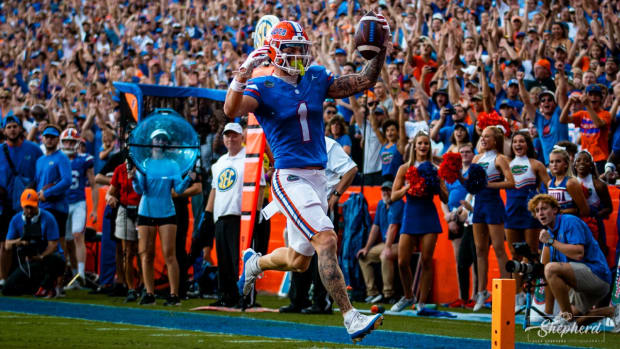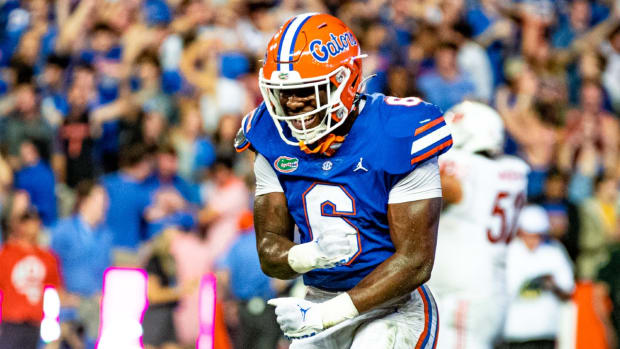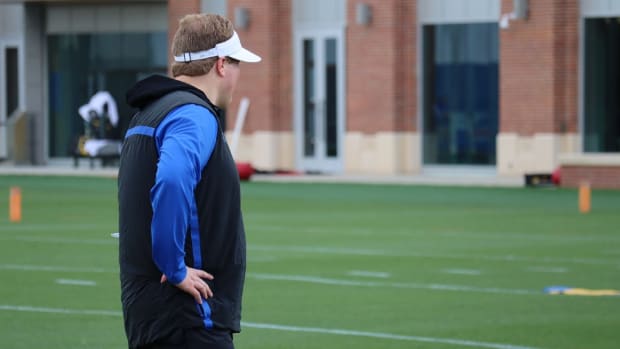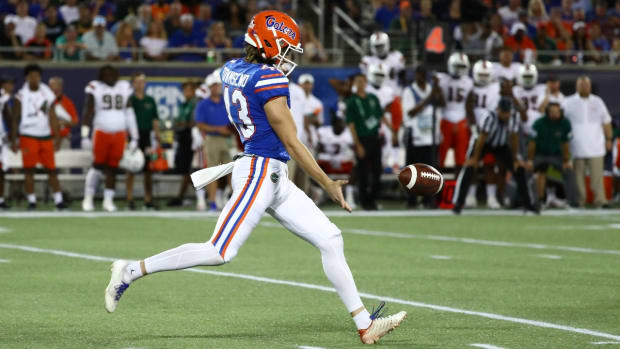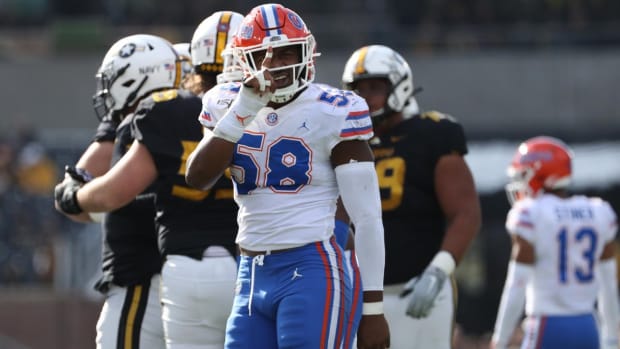Gators FILM ROOM: Kyle Pitts' Time at Wide Receiver Has Paid Off
For the first time in a long time, the Florida Gators finally have a difference-maker at tight end.
Sophomore Kyle Pitts has emerged as not only the Gators' most effective tight end, but one of their most dominant passing game weapons. And statistically, Pitts has been one of the most productive tight ends in the nation this year, tied for first among TEs in receptions with 35, tied for sixth in touchdowns with four, and ninth in yards with 391.
Simply put, it's hard to cover someone who stands at 6-6, 239 lbs., who moves like a slot receiver and runs a 4.7 40 yard dash.
But Pitts' intangibles are far from the only aspect of his game that makes him dominant. If size and speed were all it took to be a successful pass-game tight end, you'd see a lot more failed NBA players trying out for the NFL.
The position requires a blend of skills and techniques in order to be successful. And blocking, of course, but the purpose of this story is to break down Pitts' ability as a receiver.
That's what he is. He's a receiver playing tight end - and a polished one, at that.
Florida worked Pitts in at wide receiver during his freshman season and the 2019 spring camp, before eventually moving him back to his recruited position of tight end. But that training under wide receivers coach Billy Gonzales, and with route-running specialist receivers such as Van Jefferson and Josh Hammond, did Pitts' wonders.
“I think one thing that’s really helped him a lot was him playing receiver last year," Hammond told the media previously.
"Working with Coach G[onzales] and [tight ends] Coach [Larry] Scott... and being able to move a lot more fluidly and learn the routes and learn the concepts a lot better from a receiver standpoint. So now when he goes to tight end, it’s a lot easier for him to put himself in space and make the plays he has to make."
And what has that cross-training made Pitts?
"A freak," proclaimed quarterback Kyle Trask, who has seen 27 of his 114 completed passes this year - about 24% - go Pitts' way.
"He's a matchup nightmare, so any time we can get him out there one-on-one, it really helps us out a lot."
FILM ROOM
Footwork is as important as anything when it comes to route running.
The ability to stop and start your feet, whether it be to enter a vertical release off of the line of scrimmage, breaking into an angled route, changing direction, selling double moves, and so on - is crucial towards separating from coverage defenders.
One of the key aspects of football is eliminating wasted steps and keeping your foot underneath you. That makes movement less predictable to defenders, and more swift for the receiver at the same time.
Eliminating wasted movement and keeping your feet underneath you is quite the ask of a 6-6, 239 lb. specimen. At the weight and length, it shouldn't be easy to control your body through cuts and maintain both speed and balance.
But to Kyle Pitts, it is. In the clip above, Pitts times the corner route-break as soon as his body clears the peripheral vision of the coverage linebacker - a testament to Pitts' mental game and understanding defensive zones - and breaks outside with ease. He controls his strides to bend into the route, and his smooth cut keeps his lofty cushion with the deep safety intact.
And just like that, 15 yard gain. That play is just about as guaranteed to work as any in Florida's playbook with Pitts nailing the nuance of his corner route.
While the screen cuts off a bit, the same route discipline can be seen here. Facing an off-man cornerback that has outside leverage, Pitts utilizes his field space on an outside release to eliminate the cushion, working the cornerback's hips open to the boundary.
The second the cornerback's right hip becomes pointed at the sideline, Pitts wins the rep. He jab-steps with his outside foot to continue pressing the cornerback's body opposite of the route design, and cuts back to the middle of the field with plenty of space to operate in.
All the cornerback can do is hold on (literally, draping himself to Pitts' back) for dear life in order to prevent Pitts from moving down the field after the catch.
One of the reasons why polished route running is so important in Florida's offense is to open up multiple routes - a key aspect of the spread offense and one that Florida's WRs excel at.
Pitts chops it up at the top of his vertical stem long enough to set a pick to open up the underneath crossing route by Van Jefferson, and proceeds to break into his short post route - giving quarterback Kyle Trask two open options to throw the ball. The break into his post route was super clean as well, utilizing only a jab step with no other wasted steps to get open.
Another element of Pitts' game that makes him tough to guard and comes from wide receiver training is his body control.
Maneuvering through contact to run a route is difficult as is, as defenders don't shy away from contact and will put their hands on you. And when you're a long as someone like Pitts, staying balanced in your footwork without getting thrown off the stem of your route through contact becomes even tougher.
Yet, contact doesn't appear to affect Pitts whatsoever, and he has refined some moves to combat contact and remain balanced on his feet. Above, Pitts utilizes a shoulder dip to get underneath the defender's point of attack - he would have struck Pitts in the chest had Pitts stayed totally vertical.
A dip move that deep and smooth for a 6-6 tight end is bonkers, and it sets Pitts up to plant his foot and break into his corner route as soon as he clears the defender.
From the second Pitts steps off the line of scrimmage through his inside release, until he breaks at 45 degrees to the middle of the field six yards later, the opposing cornerback does nothing but push against Pitts' chest - literally, through the entire vertical stem of the route.
Yet, the contact is no matter for Pitts. He maintains his speed with long strides and rips through the defenders arms with his left arm, giving him a little shove off to separate to the middle of the field that leaves the cornerback on the ground wondering what happened. Pitts will win that rep every time.
This play may not look overly complex or impressive on Pitts' end, but again, how many players of his frame can bend and round a defender so swiftly, keeping his feet from widening out through the turn, without losing some balance?
There aren't many that I can think of.
And perhaps what's most impressive is not only does he remain balanced through the rounding of the route, but how sharp the turn is near the end to get his eyes back to Trask and to further his cushion from the deep safety. At the catch point, Pitts finds himself with about five yards of separation from both nearby defenders.
That's some nuanced route running.
All of the previously mentioned technical aspects of Pitts' game can be seen here on a catch at the boundary. He releases outside in a one-on-one, knocks the cornerback's hands off at first contact to gain ground near the boundary, and shoots vertically all while keeping his feet underneath him rather than widening out or stretching too long.
This allows Pitts to adjust swiftly to a pass thrown inside, aimed at the cornerback's back. He keeps selling vertical in order to force separation from the pass and the defender, which in itself opens up plenty of room for yards after the catch when Pitts hauls the ball in.
Pairing body control with elite size and athleticism is what allows plays like this to happen. There's not much that even needs to be broken down here - Pitts accelerates vertically into his wheel route out of the flats and gets a step ahead of the defender and makes an acrobatic, toe-tapping grab at the boundary, falling on his right side to ensure that he stays in bounds. And what a throw from Trask, too.
Kyle Pitts has been Florida's most consistently dominant weapon on offense this year, which comes as a nice surprise given the under-utilization of Florida's tight end position last season. His training at the wide receiver position sharpened his game immensely, and those same skills have translated over to the tight end position.
"You see his routes," stated Jefferson, "It's like for a tight end, you'd be like 'dang, he's doing that as a tight end.' But I think he worked harder this summer, countless times me and him in the indoor [practice facility] just working on top ends and coming in on our breaks, so I think that's working for him and he's having a great year."
